أثناء قيامك ببناء قاعدة عملائك، قد تقع في فخ واحد شائع: تخصيص جميع مواردك لجذب عملاء جدد مع اعتبار عملائك الحاليين أمراً مفروغاً منه!
ولكن، وفقًا لـ بحث نشرته هارفارد بزنس ريفيو فإن الحصول على عميل جديد يمكن أن يكلف ما يصل إلى 25 مرة أكثر من الاحتفاظ بعميل حالي! هذا هو أحد الأسباب التي تجعلك لا تتخلى عن عملائك الذين كسبتهم بشق الأنفس للمنافسين دون قتال.
تميل الشركات الأكثر نجاحاً إلى التركيز بشكل متوازن على كل من اكتساب العملاء والاحتفاظ بهم. ولكن كيف تحافظ على تفاعل العملاء وولائهم؟ 🤔
في هذه المقالة، سنستعرض ثماني استراتيجيات فعالة للاحتفاظ بالعملاء لضمان قدرة شركتك على زيادة قيمة عمر العميل إلى أقصى حد. كما سنتعمق في مقاييس الاحتفاظ بالعملاء الرئيسية لتتبع نجاح استراتيجياتك.
المكافأة: سوف نشارك بعض الميزات المتطورة في ClickUp، وهي أداة إدارة علاقات العملاء لنمو الأعمال التجارية المستدامة. ستساعدك هذه الميزات على زيادة المبيعات وتطوير علاقات أقوى مع العملاء في وقت قصير.
ما هو الاحتفاظ بالعملاء؟
إن مفهوم الاحتفاظ بالعملاء مفهوم محوري في وضع استراتيجيات الأعمال . يتعلق الأمر كله بقدرة الشركة على الاستمرار في بيع منتجاتها أو خدماتها للعملاء الحاليين ومنعهم من التحول إلى المنافسين.
تريد كل شركة أن يصبح مشتروها عملاء متكررين. ومع ذلك، فإن استراتيجيات الاحتفاظ بالعملاء مفيدة وضرورية للبقاء والنمو في أنواع معينة من الشركات. وتشمل بعض الأمثلة على ذلك:
- الخدمات القائمة على الاشتراك مثلالبرمجيات كخدمة (SaaS) مقدمو الخدمات
- الشركات العاملة في الأسواق المتخصصة حيث تكون مجموعة العملاء محدودة
- الشركات ذات دورات المبيعات الطويلة - مثلشركات B2B (بسبب الوقت والموارد اللازمة لإجراء كل عملية بيع)
ما وراء الربحية: لماذا الاحتفاظ بالعملاء مهم
الاحتفاظ بالعملاء هو أكثر من مجرد عملية ربحية.
فالاحتفاظ بالعملاء يتطلب موارد أقل من الحصول على عملاء جدد - بالإضافة إلى أن العملاء الحاليين في المتوسط من المرجح أن ينفقون 31% أكثر على أعمالك أكثر من العملاء الجدد، مما يزيد من إيراداتك بشكل مباشر.
وبمرور الوقت، تكتسب ثقة العملاء. حتى أنهم قد يطورون ارتباطًا عاطفيًا بعلامتك التجارية أو منتجك، مما يؤدي إلى رغبة أكبر في شراء المزيد أو الترقية.
إليك لمحة عامة عن الطرق الست المختلفة التي يعود بها الاحتفاظ بالعملاء بالفائدة على عملك:
- انخفاض تكاليف التسويق: العملاء المحتفظ بهم على دراية بمنتجك ويتطلبون نفقات تسويقية أقل، مما يقلل من التكاليف الإجمالية للحملة
- فرص البيع المتقاطع والبيع المتزايد: وفقًا لتقرير اتجاهات الأعمالفإن العملاء الحاليين هم أكثر عرضة بنسبة 50% لتجربة منتجاتك الجديدة أو ترقيات الخدمة
- سمعة العلامة التجارية: العملاء السعداء والمخلصون يولدون عملاء جدد من خلال الكلام الشفهي، وهي استراتيجية تسويق فعالة للغاية ومنخفضة التكلفة
- تدفقات الإيرادات التي يمكن التنبؤ بها: يوفر العملاء المحتفظ بهم تدفقات إيرادات أكثر استقرارًا ويمكن التنبؤ بها، وهو أمر حيوي للتخطيط والاستثمار على المدى الطويل
- ملاحظات للتحسين: منتظميقدم العملاء ملاحظات مستمرةمما يسمح بالتحسين المستمر والابتكار في المنتجات والعمليات
- العلاوات السعرية: العملاء الأوفياء نسبياًأقل حساسية للسعرمما يسمح للشركات بفرض أسعار مميزة
حافظ على عودتهم: 8 استراتيجيات مثبتة للاحتفاظ بالعملاء للمساعدة في الاحتفاظ بالعملاء
تتمحور الاستراتيجيات الفعالة للاحتفاظ بالعملاء حول خلق القيمة، وبناء العلاقات، وضمان رضا العملاء، وتشجيع التزامهم المستمر تجاه عملك. استخدم الاستراتيجيات الثمانية التالية لتحقيق ذلك:
1. الحفاظ على الجودة والموثوقية
يعد تقديم منتجات أو خدمات عالية القيمة باستمرار والوفاء بالتزامات العملاء حجر الزاوية لنجاح الأعمال على المدى الطويل. فهو يؤثر على سمعة علامتك التجارية وكذلك الاحتفاظ بالعملاء.
إليك بعض النصائح العملية لمساعدتك على كسب ولاء العملاء من خلال التميز:
- تنفيذ إجراءات صارمةمراقبة الجودة في كل مرحلة من مراحل عملية تطوير الخدمة أو المنتج الخاص بك
- توفير تدريب شامل للموظفين للحفاظ على معايير عالية من الخدمة
- تقديم ضمانات أو كفالات لطمأنة العملاء
استخدام منصة إدارة المشاريع مثل انقر فوق يمكن أن تقطع شوطًا طويلاً في الحفاظ على الجودة والموثوقية. معالم ClickUp Milestones و أهداف النقر يمكن أن تساعد في إعداد وتتبع العملاء الرئيسيين التسليمات من حيث الجودة والكمية على حد سواء. ضع معايير قابلة للقياس لفريقك بحيث تكون منتجاتك وخدماتك متقنة قبل وصولها إلى العميل. 🌸
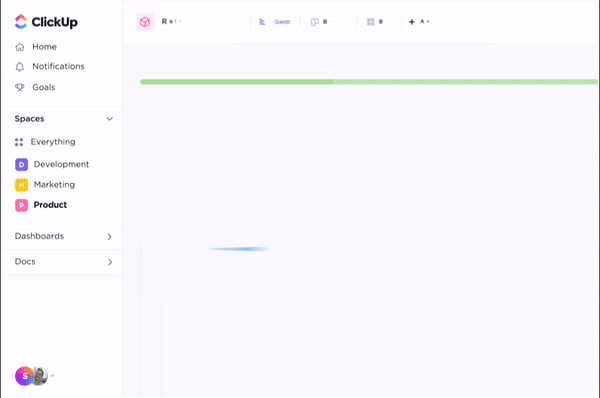
قم بتحويل أهم مهامك إلى معالم رئيسية لإنشاء تمثيل مرئي للتقدم المحرز في مشاريعك
يمكنك أيضًا إنشاء قوائم تدقيق ومهام فرعية لضمان استيفاء عملياتك الداخلية للمعايير المحددة. هذا النهج المنظم يجعل من السهل حساب جميع مجالات المشروع وإدارتها بفعالية. استخدم خاصية ClickUp قوالب تحسين العمليات لتقليل أوجه القصور وإعادة توجيه الموارد نحو الأنشطة التي تعزز جودة منتجاتك أو خدماتك.
على سبيل المثال، فإن ClickUp PDCA (التخطيط، والتنفيذ، والتحقق، والتصرف) قالب السبورة البيضاء للعملية هو أداة ممتازة لتصور العمليات وإيجاد فرص لتعزيز رضا العملاء.
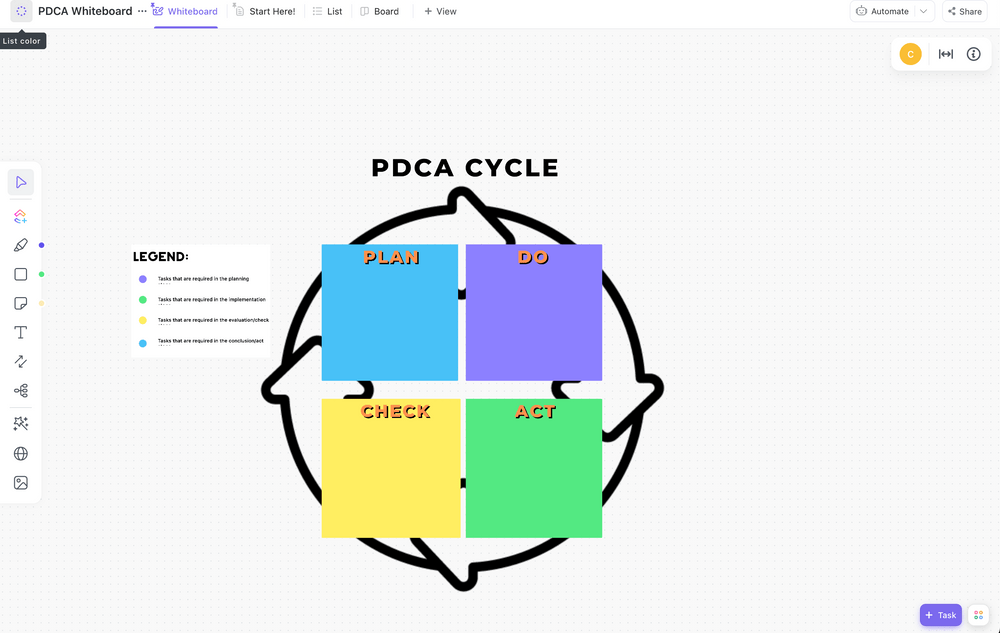
استخدم هذا القالب المرئي لتقسيم المهام إلى أجزاء يمكن إدارتها من خلال تصنيف العناصر إلى أربع مراحل: التخطيط، والتنفيذ، والتحقق، والتصرف
2. تقديم خدمة مخصصة
ترتكز استراتيجية الاحتفاظ بالعملاء هذه على فهم أن كل عميل فريد من نوعه. عندما تقوم بتخصيص خدماتك لتلبية الاحتياجات والتفضيلات الخاصة بكل عميل، فإنك:
- تحسين تجربة العميل: التخصيص يجعل العملاء الحاليين يشعرون بالتقدير والاهتمام، مما يؤدي إلى تحسين معدلات المشاركة
- اكتساب ميزة تنافسية: في سوق مليء بالمنتجات أو الخدمات المتشابهة، يمكن أن يكون التخصيص عاملًا رئيسيًا في التمييز
- الوصول إلى رؤى مستندة إلى البيانات: يتضمن تطبيق الخدمة المخصصةجمع وتحليل تفضيلات العملاء وسلوكياتهم، والتي يمكن أن توفر رؤى قيمة يمكن أن تساعد في تشكيل تطوير المنتجات واستراتيجيات الأعمال الأوسع نطاقًا
باستخدام ClickUp، يمكنك تخصيص كل حساب عميل ليعكس تدفقات العمل الفريدة. كما أن المنصة تتميز بالعديد من طرق العرض المخصصة مثل طريقة عرض Gantt وطريقة عرض القائمة، تمنحك رؤى جديدة حول سجل معاملات العميل ونمطها. الاستفادة من الحقول المخصصة والحالات المخصصة، والقوالب المخصصة لإنشاء حقول مخصصة خطط المشروع والمهام التي تلبي المتطلبات الخاصة بكل عميل.

إضافة حقول مخصصة مطلوبة إلى المهام والقوائم لضمان اتباع نهج مخصص لكل عميل
على سبيل المثال، أنت تحاول إبهار عميل بخدمات لوجستية أسرع للتوصيل. في هذه الحالة، يمكنك استخدام التذكيرات وتقديرات تتبع الوقت داخل ClickUp لتتبع المواعيد النهائية بدقة و إدارة الوقت .
3. قم بتضمين قيمة إضافية في خدمتك
يمكنك أن تجعل عملك متميزًا من خلال تجاوز توقعات العملاء الأساسية لمنتجاتك أو خدماتك. يمكن أن تشمل القيمة الإضافية رؤى الصناعة أو المحتوى التعليمي أو المشورة إلى جانب السلعة الأساسية التي تقدمها. سيقدّر عملاؤك هذا الجهد الإضافي، مما قد يجعل عملك التجاري شريكًا ذا قيمة في الموارد.
من الناحية العملية، قد تتضمن استراتيجية القيمة المضافة ما يلي:
- إنشاءقاعدة معرفية شاملة أو دليل المنتج
- استضافة ندوات تعليمية عبر الإنترنت بانتظام
- إرسال النشرات الإخبارية التثقيفية
- تقديم الاستشارات أو التقييمات المجانية
هل تتطلع إلى تطوير مواد تقنية أو تعليمية للعملاء؟ مستندات ClickUp يسمح لك بإنشاء محتوى احترافي عالي الجودة ومشاركته. قم بإعداد أدلة أو برامج تعليمية أو مستندات دعم مفصلة وتنظيمها بطريقة منظمة داخل الأداة. إذا كنت تبيع برامج، يمكنك أيضًا تسجيل شاشتك إلى إنشاء مقاطع فيديو تعليمية سهلة المتابعة باستخدام Clip للحصول على دعم إضافي!
يقدم ClickUp مجموعة متنوعة من القوالب لإنشاء مستندات موجهة للعملاء، مما يوفر لك الوقت ويضمن الاتساق في المواد التي تنتجها. بالإضافة إلى ذلك، ClickUp AI يمكن أن يساعدك في عملية الكتابة من خلال:
- تحسين مستنداتك من حيث الأسلوب والقواعد النحوية
- إنشاء المستندات التقنية ومستندات التواصل من الصفر بناءً على المطالبات
- تلخيص رسائل البريد الإلكتروني للعميل والمواد المعرفية

استخدام ClickUp AI لإنشاء منشور مدونة في ClickUp Docs من مطالبة بسيطة لإضافة التفاصيل والجوانب المهمة الأخرى
4. استهداف التواصل المتسق متعدد القنوات
ينطوي تنفيذ استراتيجية التواصل متعدد القنوات على دمج قنوات الاتصال متعددة القنوات أدوات وقنوات الاتصال الخاصة بك بحيث تتدفق المعلومات بسلاسة فيما بينها. من المهم للغاية تقديم خدمة عملاء قوية، حيث تحتاج إلى التأكد من أن المحادثة التي تبدأ على إحدى القنوات يمكن أن تستمر على قناة أخرى دون فقدان السياق.
من الناحية المثالية، إذا أنشأت حضوراً على منصات تواصل متعددة حيث ينشط عملاؤك، يمكنهم الوصول إليك من خلال طرقهم المفضلة. يجب عليك أيضًا إنشاء طريقة لتتبع مشكلات العملاء وطلباتهم عبر القنوات.
قد يكون الحفاظ على منصات تواصل متعددة أمرًا صعبًا، ولكن لدينا الحل! الاستفادة أكثر من 1,000 عملية تكامل في ClickUp ، بما في ذلك تلك التي مع أدوات مثل Slack وMicrosoft Teams والبريد الإلكتروني، لتركيز مراسلات العملاء.
بالإضافة إلى ذلك، يمكنك استخدام التعليق و عرض الدردشة ميزات لتنظيم جميع الاتصالات المتعلقة بالعميل داخل ClickUp. يمكن ل ClickUp AI أيضًا أن يجعلك على اطلاع على آخر المستجدات من خلال تلخيص سلاسل المحادثات وتحسين سرعة و جودة خدمة العملاء لديك في العملية

يقوم ClickUp Chat بتخزين جميع تعليقاتك في ClickUp للعثور بسرعة على أي محادثة
5. ضع في اعتبارك برامج الولاء والحوافز
يشجع برنامج ولاء العملاء أو الحوافز على تكرار الأعمال من خلال مكافأة العملاء على دعمهم المستمر. يمكن لهذه البرامج أن تزيد من تواتر عمليات الشراء وتعزز العلاقة العاطفية للمشتري مع العلامة التجارية. هناك عدة أنواع من حوافز الولاء التي يمكنك إطلاقها، مثل:
- خصومات لتشجيع العملاء على إجراء عمليات شراء مستقبلية
- الوصول الحصري إلى منتجات أو خدمات جديدة
- مزايا العضوية
- أنظمة المكافآت القائمة على النقاط
- تقدير خاص أو فئة عملاء خاصة
باعتباره حلاً متكاملاً لإدارة المشاريع، يمكن لـ ClickUp تبسيط إدارة حوافز الولاء الخاصة بك بشكل كبير. أولاً، يجب عليك إنشاء قوائم أو مجلدات لبرامج الولاء النشطة الخاصة بك. يمكن أن يكون لكل عميل مهمة أو قائمة حيث يمكنك تتبع أهليته للحصول على المكافآت والمكافآت الممنوحة بالفعل.
يمكنك استخدام طرق عرض اللوحة أو الجدول لتمثيل موقف كل عميل في برنامج الولاء الخاص بك بشكل مرئي، مما يسهل إدارة وتتبع التقدم المحرز.
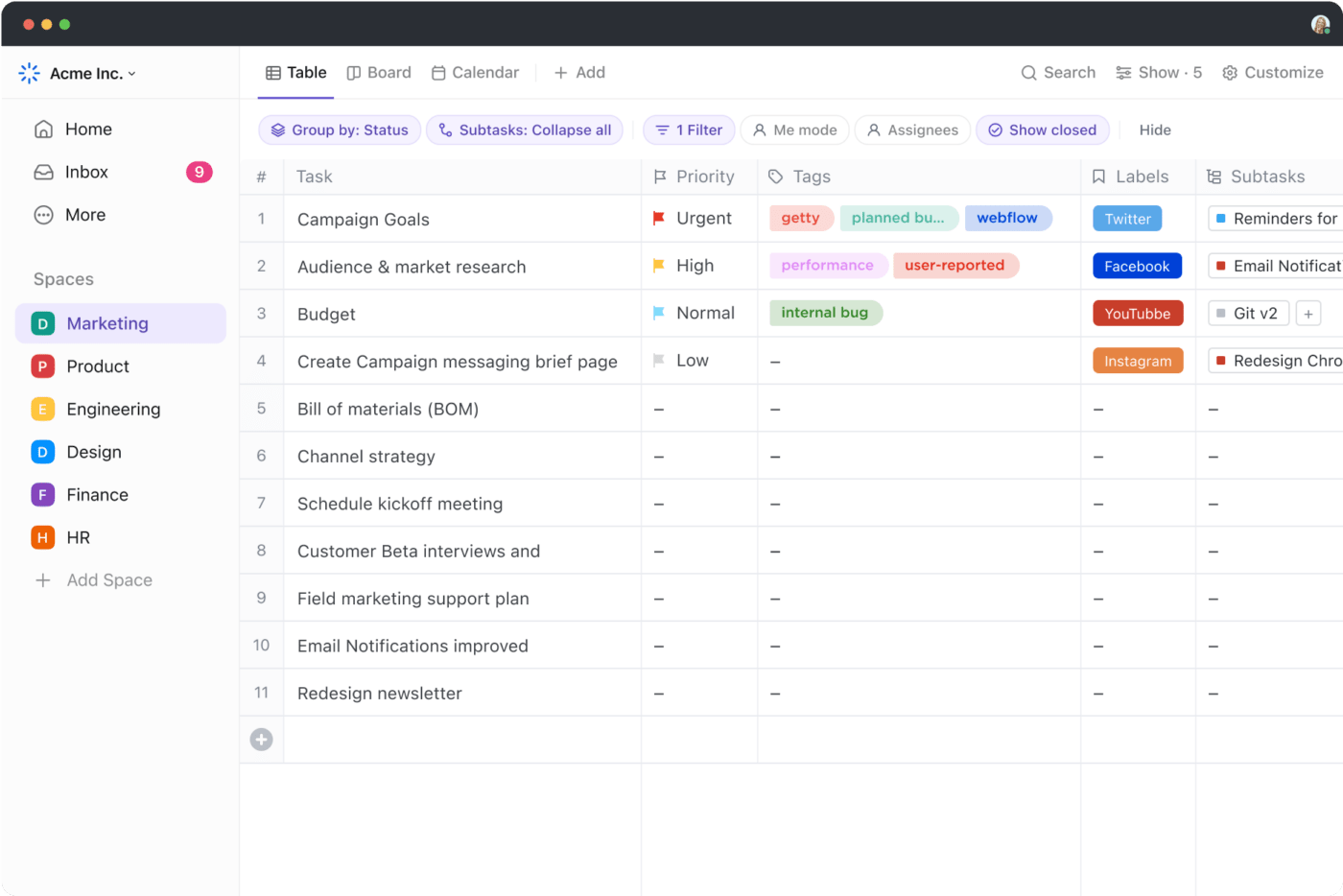
قم بتنظيم المهام وفرزها وتصفيتها في طريقة عرض الجدول ClickUp 3.0 ClickUp 3.0 للحصول على رؤى أسرع عبر جميع أعمالك
بعد ذلك، قم بإعداد انقر فوق التشغيل التلقائي لتشغيل التذكيرات أو الإجراءات عندما يصل العميل إلى مرحلة مهمة تؤهله للحصول على مكافأة ولاء.
6. اعتماد نهج حل المشكلات
تحديد و معالجة المشاكل بشكل استباقي قبل تفاقمها يعزز رضا العملاء وولاءهم. فهو يدل على أن مخاوف العملاء مهمة وأن الشركة ملتزمة بحلها. إليك بعض النصائح العملية لتنفيذ هذه الاستراتيجية:
- مراجعة العملاء بشكل منتظم: جدولة مواعيد دورية مع العملاء لمناقشة تجربة المستخدم أو المنتج وأي تحديات قد يواجهونها
- التواصل الشفاف: إبقاء العملاء على علم بالخطوات التي تتخذها لحل مشاكلهم لأن التحديثات المنتظمة تبعث على الاطمئنان
- تحليل الأسباب الجذرية: اعثر على السبب الأساسي وراء المشكلة وقم بتطوير حلول تمنع حدوث مشاكل مماثلة في المستقبل. استخدمنموذج تحليل الأسباب الجذرية لـ ClickUp لتبسيط العملية
- تحسين العمليات باستمرار : استخدم الرؤى المكتسبة من حل المشكلات لتحسين عملياتك وخدماتك وتفاعلاتك مع العملاء
مخصص لوحات المعلومات في ClickUp هي طريقة سهلة للبقاء على اطلاع على مشاكل العميل وحالة الحلول. يمكنك إضافة بطاقات تعرض المهام قيد التنفيذ والمواعيد النهائية القادمة, توزيع عبء العمل وغير ذلك. على سبيل المثال، يمكنك تخصيص بطاقة للكشف عن العمل الموزع بشكل غير متساوٍ والذي يمكن أن يؤدي إلى اختناقات ومشكلات في الجودة.
يمكنك إعداد الإشعارات والتنبيهات عندما تخرج المهام عن المسار الصحيح. يضمن ذلك لفت انتباهك إلى المشكلات المحتملة على الفور.
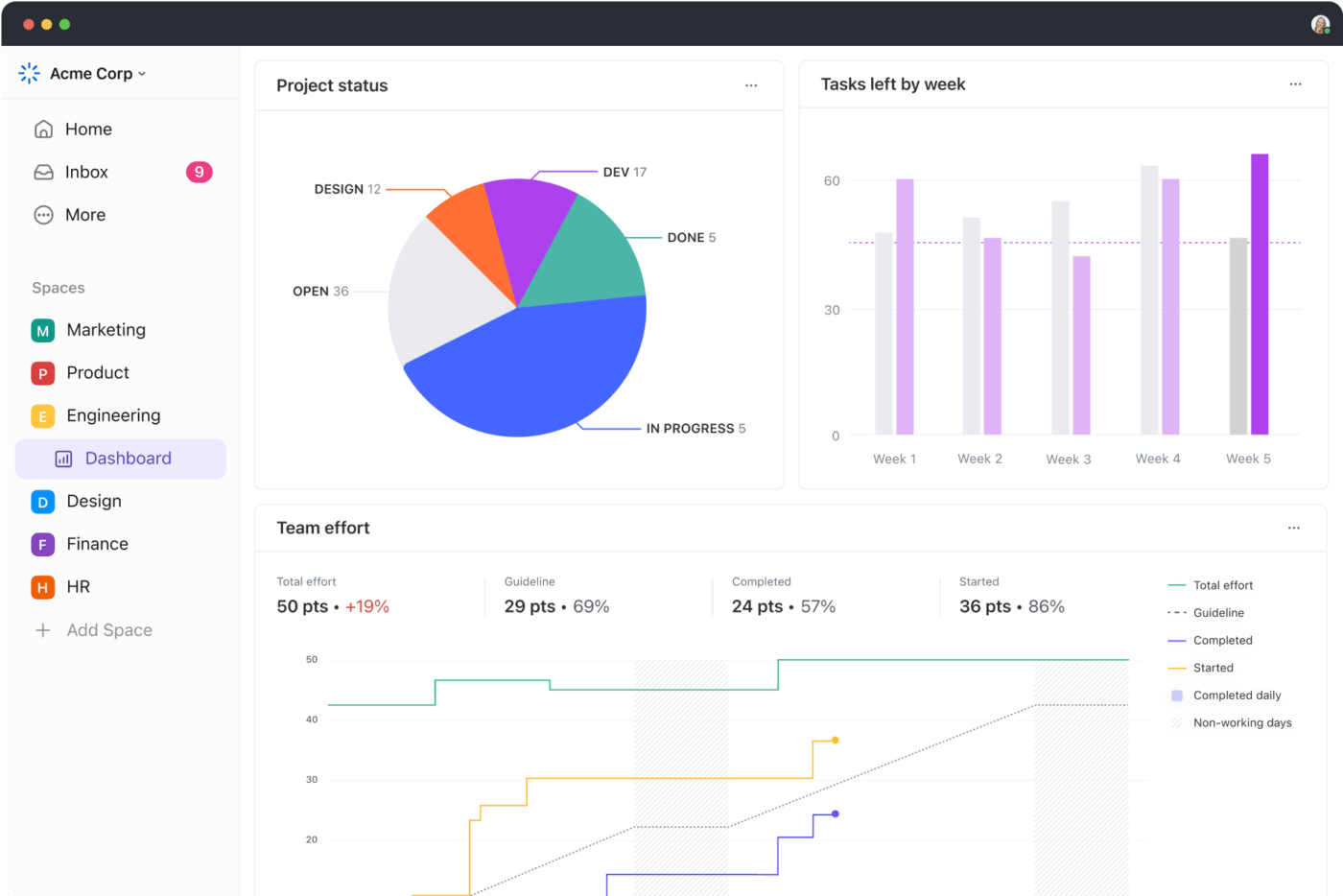
احصل على عرض شامل لحالات المشروع والمهام المتبقية في فريقك أو قسمك باستخدام لوحات المعلومات في ClickUp 3.0
7. إنشاء حلقة ملاحظات العملاء
يمكن أن يكشف جمع ملاحظات العملاء بانتظام عن اتجاهات الصناعة الجديدة أو تفضيلات العملاء أو الاحتياجات الناشئة، مما يوجه تطوير منتجات أو خدمات أكثر ملاءمة للسوق.
حلقة التغذية الراجعة للعملاء هي عملية تطلب فيها الشركة الحصول على ملاحظات العملاء، وتستمع إلى ما يقوله العملاء، وتجري تغييرات بناءً على تلك الملاحظات، ثم تخبر العملاء بما تم تغييره. يمكن أن يؤدي إشراك العملاء في عملية التغذية الراجعة إلى تعزيز المجتمع، مما يمنحهم حصة في نجاح شركتك ونموها.
لتحقيق الفعالية جمع ملاحظات العملاء يمكن للشركات استخدامها:
- الاستبيانات
- نماذج الملاحظات على المواقع الإلكترونية
- المقابلات المباشرة
- مناقشات جماعية مركزة
- المشاركة عبر وسائل التواصل الاجتماعي
- صناديق الملاحظات، إذا كان للنشاط التجاري عنوان فعلي
يمكنك إعداد قابل للتخصيص نماذج ClickUp لجمع الملاحظات من عملائك. ستنشئ كل استجابة تلقائيًا مهمة في ClickUp، لذلك سيكون لديك جميع ملاحظات العملاء منظمة بدقة في مكان واحد. يمكنك تعيينها الحالات المخصصة مثل ملاحظات جديدة، تحت المراجعة، تحت المراجعة، إجراء تم اتخاذه، تم حلها.
عندما تبدأ في تنفيذ التغييرات بناءً على هذه الملاحظات، يجب عليك تتبع التقدم المحرز في الإجراءات الموصى بها - إكمال المهام يغلق الحلقة.

اجمع ملاحظات العملاء من خلال نماذج ClickUp للتعرف على آراء عملائك وآرائهم
8. استثمر في بناء العلاقات
يتضمن بناء العلاقة إنشاء ورعاية علاقة أعمق وأكثر جدوى مع عميلك. لا يتعلق الأمر فقط بالبقاء على اتصال بل بالتعاطف الفعال مع احتياجاتهم الفريدة وتقديم حل مدروس.
إليك ما يعنيه ذلك عملياً:
- الصدق في جميع المواقف: كن صريحًا بشأن ما يمكنك تقديمه. فهذا يبني الثقة، وسيقدّر العملاء ذلك. أظهر اهتمامًا حقيقيًا بنموهم ورفاهيتهم واسألهم عن التحديات التي تواجههم في أعمالهم وتطلعاتهم
- متابعة ما بعد البيع: بعد إتمام عملية البيع أو المشروع، تابع ما إذا كان العميل راضٍ عن عملك وتلبية أي احتياجات أو مشاكل إضافية
- مبادرات تقدير العميل: إرسال رسائل شكر أو بطاقات معايدة أو بطاقات تهنئة بالعطلة أوهدايا صغيرة للاحتفال بالمعالم البارزة للعملاء مثل الذكرى السنوية للأعمال أو الإنجازات المهمة 💐
- مشاركة قصص نجاح العملاء (بإذنهم): هذا يدل على أنك تدعمهم وتقدر شراكتهم
إن حفظ كل التفاصيل عن كل عميل أمر مستحيل، ولكن لحسن الحظ، ClickUp هنا لمساعدتك. يمكنك استخدام مستندات وتعليقات ClickUp لتوثيق التفاعلات مع العملاء، بما في ذلك ملاحظات الاجتماعات، والمكالمات، وملخصات البريد الإلكتروني.
تقدم المنصة مجموعة مختارة من قوالب ملف تعريف العميل لتخزين معلومات مخصصة عن كل عميل. فهي تساعدك على تكييف نهجك وابتكار طرق مبتكرة لإرضاء عملائك. عرض التقويم الخاص بـ ClickUp والتذكيرات تضمن لك عدم نسيان التواريخ والاجتماعات والزيارات المهمة لعميلك.
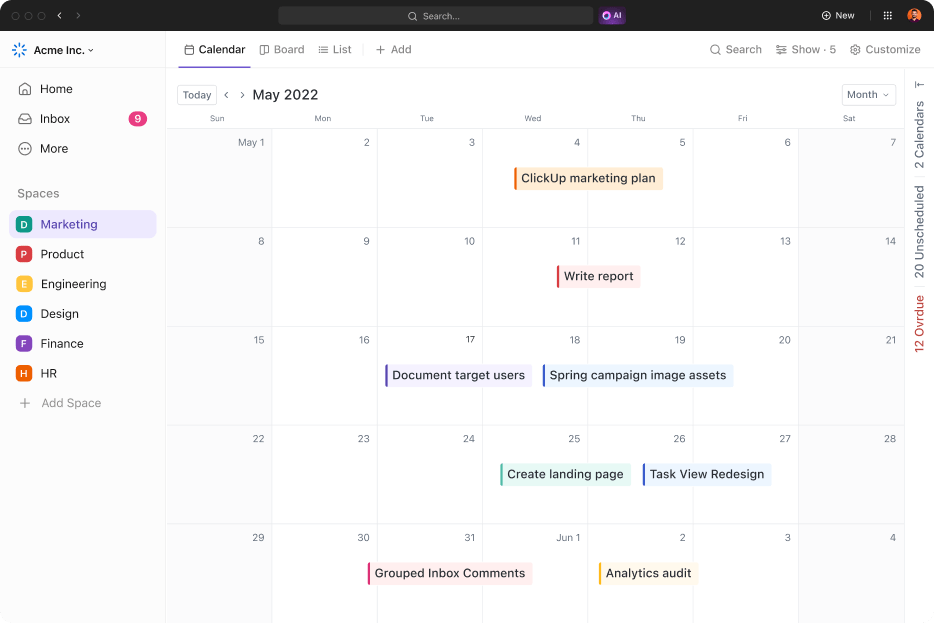
استخدم طريقة عرض التقويم لتتبع تواريخ الاستحقاق، وتفعيل التذكيرات حتى لا يفوتك أي موعد نهائي، وإدارة المشاريع بسهولة باستخدام ClickUp
مقاييس يجب معرفتها: معدل تراجع العملاء مقابل معدل الاحتفاظ بالعملاء
يؤثر الاحتفاظ بالعملاء (أو عدمه) بشكل كبير على صحة الشركة على المدى الطويل. إذا كنت ترغب في الحصول على الصورة الكاملة لولاء العملاء ورضاهم، فإن تتبع المقاييس مثل معدلات زبد العملاء ومعدلات الاحتفاظ بالعملاء أمر ضروري. إليك كيفية المقارنة بين الاثنين:
| مقياس | معدل زبد العملاء | معدل الاحتفاظ بالعملاء |
|---|---|---|
| التعريف | يقيس النسبة المئوية للعملاء الذين يتوقفون عن التعامل مع شركة ما خلال فترة محددة | يقيس النسبة المئوية للعملاء الذين تتمكن الشركة من الاحتفاظ بهم خلال فترة محددة |
| الحساب | (عدد العملاء الذين فقدوا خلال الفترة ÷ عدد العملاء في بداية الفترة) \ * 100 \ \ \ \ [(إجمالي العملاء في نهاية الفترة - العملاء الجدد خلال الفترة) \ ÷ إجمالي العملاء في بداية الفترة \ \ \ \ \ \ \ \ \ 100 | |
| مثال | إذا بدأت العام مع 100 عميل وفقدت 5 منهم بحلول نهاية العام، فإن معدل الاحتفاظ السنوي سيكون 5% | إذا كان لديك 100 عميل في بداية العام، وفقدت 5 عملاء ولكنك كسبت 10 عملاء جدد، فإن معدل الاحتفاظ سيكون 95% |
| النتيجة المرغوبة | منخفضة - يشير انخفاض معدل الاحتفاظ بالعملاء إلى معدل احتفاظ ورضا أفضل للعملاء | مرتفعة - يشير ارتفاع معدل الاحتفاظ إلى ولاء العملاء القوي واستقرار الأعمال |
| المقاييس | عدد العملاء الذين تخسرهم الشركة | ولاء العملاء والنجاح في جهود الاحتفاظ بهم |
| الأهمية | يشير إلى الرضا وجودة الخدمة، بالإضافة إلى تأثيره على الإيرادات والنمو | يشير إلى ولاء العملاء ومشاركتهم، مما يوفر إمكانية التنبؤ بالإيرادات إلى حد ما |
كلا المقياسين متكاملان ويشتركان في هذه العلاقة:
معدل دوران العملاء = 100% - معدل الاحتفاظ
فوائد استخدام برنامج الاحتفاظ بالعملاء
الاحتفاظ بالعملاء هو مجموعة واسعة من العمليات. لا يمكن التعامل معها يدويًا، لذا فأنت بحاجة إلى أدوات ومنصات رقمية لتتبع علاقات العملاء وإدارتها وتعزيزها. باستخدام برنامج الاحتفاظ بالعملاء استمتع
- الكفاءة وقابلية التوسع: يعمل البرنامج على تبسيط وأتمتة عمليات إدارة علاقات العملاء، مما يتيح سهولة التوسع مع نمو الأعمال
- إدارة البيانات وتحليلها: تتباهى هذه الأدوات بقدرات متطورة لجمع البيانات وتخزينها وتحليلها، وتقدمرؤى قيمة حول سلوك العميل
- الاتصال المتكامل: يساعد دمج قنوات الاتصال المختلفة على توفير ردود سريعة ومتسقة على استفسارات العملاء
تسخير قوة ClickUp للاحتفاظ بالعملاء بشكل فعال
ClickUp عبارة عن منصة قوية لإدارة العمل توفر مجموعة كاملة من الإمكانيات للاحتفاظ بالعملاء وبناء العلاقات وغير ذلك الكثير.
على سبيل المثال، يمكنك استخدام طرق العرض المتنوعة، مثل طريقة عرض القائمة أو اللوحة أو الجدول، لمراقبة المشاريع الجارية والتواصل مع العملاء وأي جهود محددة للاحتفاظ بالعملاء بطريقة بديهية ومنظمة.
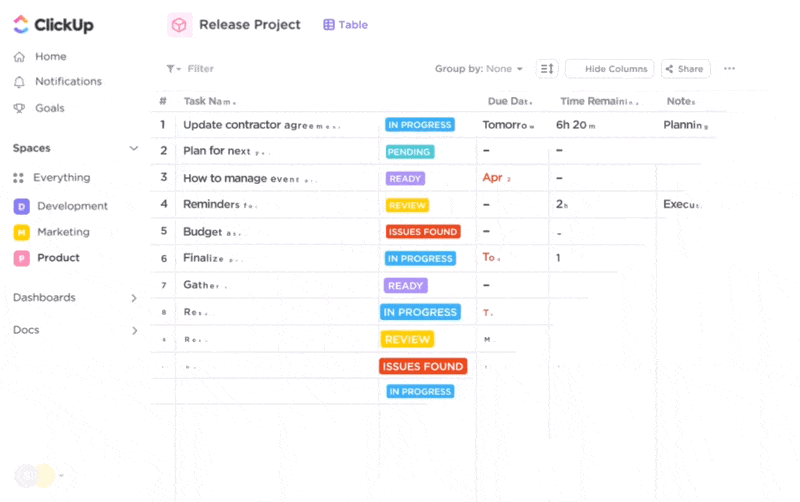
تصوّر جميع جوانب مشاركة العميل وإدارتها باستخدام أكثر من 15 طريقة عرض من ClickUp
داخل ClickUp مجموعة إدارة علاقات العملاء ، ستجد ثروة من الأدوات اللازمة لبناء قاعدة بيانات العميل . تم تصميمه مسبقًا قوالب إدارة علاقات العملاء مصممة خصيصاً لتنظيم معلومات العميل بفعالية وتتبع تفاعلات العميل، وكلها قابلة للتخصيص حسب احتياجاتك. التقط المعلومات الأساسية، مثل تفاصيل الاتصال والتفضيلات والمعالم الرئيسية، واحتفظ بكل شيء منظم في مجلدات مرتبة.
بالإضافة إلى ذلك, نظام إدارة المهام في ClickUp يمكن تخصيصه لكل نشاط من أنشطة الاحتفاظ بالعملاء، سواء كانت مكالمات المتابعة، أو استطلاعات الرضا، أو مبادرات خاصة لمشاركة العملاء. كما أنه يحتوي على مجموعة المبيعات حيث يمكنك إدارة العملاء المحتملين والإشراف على خطوط أنابيب المبيعات بسهولة.
يمكن لـ ClickUp Automations القابلة للتخصيص تشغيل إجراءات مثل إرسال رسائل شكر عبر البريد الإلكتروني أو جدولة الاجتماعات أو تحديث حالة العميل، وكل ذلك يساهم في عملية استبقاء مبسطة.

عرض الأتمتة النشطة وغير النشطة وإدارتها بسرعة عبر المساحات مع تحديثات المستخدم وأوصافها
توفر أدوات إعداد التقارير الأصلية في ClickUp رؤى حول المقاييس الرئيسية للاحتفاظ بالعملاء وأداء المبيعات وإنتاجية الفريق. تُعد هذه التحليلات ضرورية لفهم فعالية استراتيجياتك واتخاذ القرارات المستندة إلى البيانات.
نفّذ استراتيجيات طموحة للاحتفاظ بالعملاء باستخدام ClickUp
يعتمد الاحتفاظ بالعملاء على فهم توقعات العملاء واحتياجاتهم وتفضيلاتهم وتلبيتها. يبرز ClickUp كحليف قوي في تطبيق استراتيجيات الاحتفاظ بالعملاء على إدارة علاقات العملاء اليومية والمشرفين وسير عمل الاتصالات.
من خلال دمج ClickUp في جهود الاحتفاظ بالعملاء، يمكنك ضمان اتباع نهج أكثر اتصالاً واستجابة وتركيزًا على العميل - من خلال اشترك مجانًا وتحقق من ذلك بنفسك! 🌞

